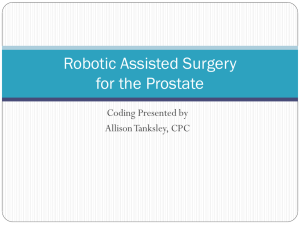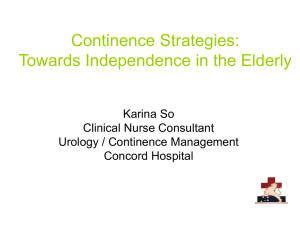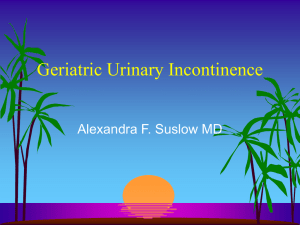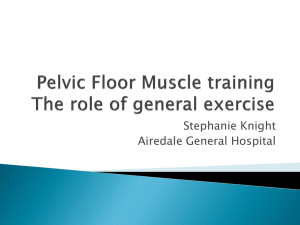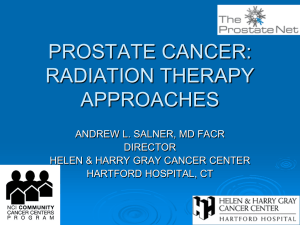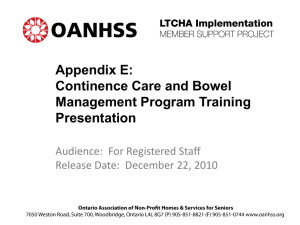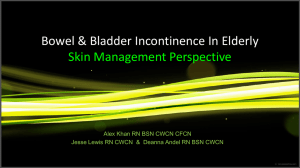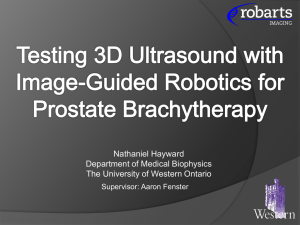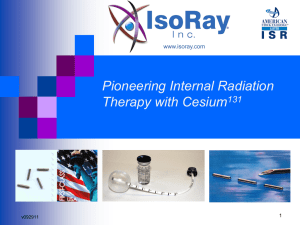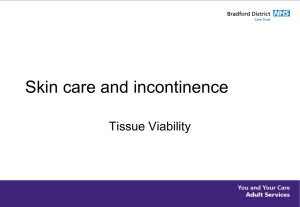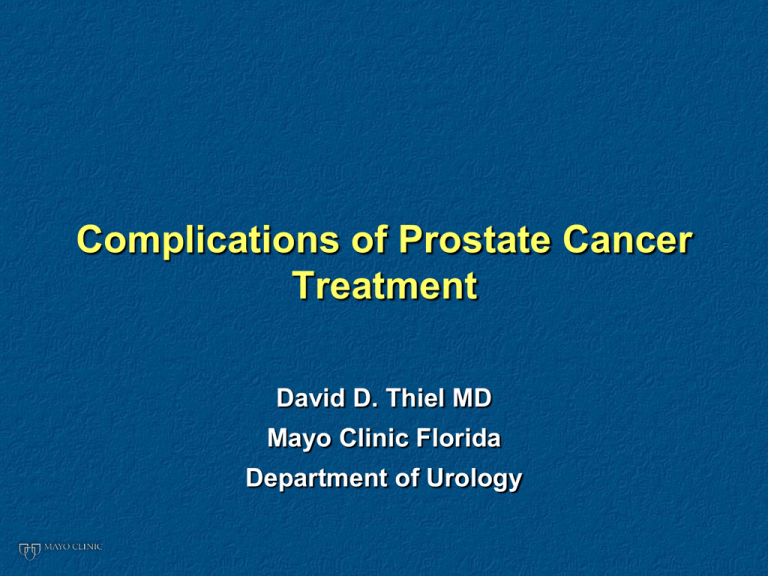
Complications of Prostate Cancer
Treatment
David D. Thiel MD
Mayo Clinic Florida
Department of Urology
What about pain?
• Pain is not an element of prostate
cancer unless there are bone
metastasis
• Treated with androgen
deprivation, steroids, etc
Prostate Cancer Options
• Watchful waiting
• Active surveillance
• Surgery
•Retropubic
•Perineal
•Robotic
• Radiation Therapy
•External beam
•Brachytherapy
•Proton Beam
•
•
•
•
Cryotherapy
HIFU
Cyber knife
Androgen
deprivation (ADT)
Prostate Cancer Therapy Goals
• Eradicate Cancer
• Preserve Continence
• Prevent Regret
• Preserve Erections
Quality of Life
Quality of life does Matter!!!
• HRQOL is #1 concern of men electing
therapy for Pca (JUrol 2003)
• AUA survey (2000) of 1000 men
• 74% of men over 50 are “afraid” to
have PSA checked due to possible
side effects of Pca treatment.
• ITS NOT THE BIOPSY THEY ARE
SCARED OF
No free lunch
• There is no such thing as treatment
for prostate cancer that doesn’t have
the risk of incontinence and erectile
dysfunction
“The Trifecta”
• The 3 C’s
• Cure – Is psa unetectable
• Continence
• Coitus
Continence
• What is continence?
• No pads ever
• Is “insurance pad” continence?
• “Social continence”
• Surgical intervention? If no surgery
needed, incontinence isnt that bad
• Return to baseline urinary fx
• Some studies use AUA score!!!!
Continence
• Everyone’s true fear
• Seldom marketed. Why?
• NOT COMMON
3 Types of incontinence
• 1. Stress incontinence
• Cough and sneeze
• 2. Urge incontinence
• Cant get there in time
• 3. Mixed incontinence
Stress Incontinence
• Is a sphincter problem
• See in all patients following RRP
• Occurs following XRT as well
Incontinence
• All men are incontinent following
surgery
• Continence must be regained
• Incontinence rates following RALP
around 1-3%
• 7% require an insurance pad
Kegel excercises
True Trifecta
(RALP)
• Eliminate high grade disease (G8, 9,
10) and metastatic disease
• Eliminate obesity (BMI >35)
• Eliminate SHIM score <20
• Eliminate hormones
• Eliminate neurologic diagnosis
• TRUE TRIFECTA 50-55%
AUS: Treatment Outcomes
• Published results on patients
achieving and maintaining social
continence (significantly improved)
after AUS for post prostatectomy
incontinence :
• Gundian et al. 90% J. Urol. 142:
1989
• Marks et al.
95% J. Urol.
142: 1989
• Perez et al.
85% J. Urol.
148: 1992
Urge Incontinence
• More common after radiation
• Is a sign of obstruction or bladder
irritation
• Surgery removes obstruction
Is Brachy a Kinder and Gentler
Option?
• “Brachytherapy is the most
convenient treatment and has lowest
rates of long-term complications
compared to RRP or XRT”
- Grills, et al. (William Beaumont Hospital) J Urol 2003
Table 6
Grade 2 Toxicity Refresher
• Dysuria – relieved with medication
• Incontinence – some control
• Hesitancy requiring I/O cath or
indwelling catheter
• Urgency – Increased but not more
than once an hour
• Hematuria not requiring tranfusion
Table 7
•
Grade 2 Toxicity Refresher
• Diarrhea – 4- 6 stools per day. Not
incontinent of stool
• Rectal Pain – Pain requiring
analgesics that does not interfere
with quality of life
• Rectal Bleeding – Requires
medication but not transfusion
Incontinence following radiation
(Urge and/or stress)
• Also operator dependent
• Seeds in wrong place
(brachytherapy)
• Radiate wrong place (XRT)
Urinary bother after radiation
• Alpha blocker therapy
• Flomax, Rapaflow, Uroxatrol, etc.
• Anticholenergic Therapy
• Detrol, Enabelex, Ditropan, etc
• O2 Chamber
Worse-case scenario
• Urinary diversion
• Stool diversion
• Double bag
RUG
Devasting Comlications
The best treatment for Radiation
Induced voiding dysfunction
• PREVENTION
• Avoid big prostates
• Avoid those with urinary bother
• Avoid those with inflammatory
bowel disease (rectal bother)
• Avoid those with high residuals
• Avoid those with “prostatitis”
Erections
“The soul of man”
• The biggest misconceptions
• The biggest marketing target
• The only reason men make bad
choices
• In life
• AND in prostate cancer
Marketing
“Guaranteed erections”
• HIFU
• Selective cryotherapy
• Gamma knife
• All pray on the “super-educated”
• Too smart for their own good
Defining ED in the Setting of Radical
Prostatectomy
Multivariate Analysis: Clinical and Pathologic Factors
Significant Variables
P value
Age
Full potency preoperatively
Neurovascular bundle (NVB) status
Surgical technique (pre- and post-1993)
0.0008
0.0039
0.0204
0.0001
Not Statistically Significant Variables
Pathological stage
Tumor volume
Preoperative prostate-specific antigen
UICC stage
Surgical margins
0.1279
0.1483
0.3336
0.5605
0.7534
UICC=Union Internationale Contre le Cancer.
Quinlan et al J Urol 1991; 145(5):998.
Rabbani, Stapleton, Scardino. J Urol 164:1929, 2000.
Erectile Dysfunction
One Pitfall After Another
1. What is potency? (PDE5 use, etc.)
2. When is potency defined? (1 day
vs 18 mos, etc.)
3. How is potency assesed?
4. Who is reporting the potency?
(Marketing of technology)
Sexual Dysfunctions Following Radical
Prostatectomy
• Changes in penile morphometry
• Penile length alterations
• Penile curvature
• Anejaculation
• Changes in Orgasmic function
• Anorgasmia
• Dysorgasmia (pain)
• Increased intensity
• Climacturia (sex specific urine leakage)
• Erectile Function
• Complete ED
• Partial erections
• Change in pharmacologic responsivity
Quality of Life Depends
on Prostate Cancer Procedure
Prostatectomy
*
20
0
*
*
0 2
6
*
*
12
24
Follow-up
(months)
60
†
†
†
†
40
20
*
*
0
0 2
6
*
*
Brachytherapy alone
Brachytherapy plus
radiotherapy, NHT, or both
80
Sexual Score
*
*
*
Sexual Score
Sexual Score
60
40
Radiotherapy plus NHT
80
Non-nerve-sparing
100
Radiotherapy alone
Nerve-sparing
80
Brachytherapy
Radiotherapy
100
100
60
*
*
*
40
20
*
*
0 2
6
*
*
0
12
24
Follow-up
(months)
*P<0.01
†Significant, but below the threshold of clinical relevance
NHT = neoadjuvant hormone therapy
Scores based on the Expanded Prostate Cancer Index Composite (0-100)
12
Follow-up
(months)
N=1201
Sanda MG, et al. N Engl J Med. 2008;358:1250-1261.
24
Percentage of Prostatectomy Patients
Reporting Specific Levels of Distress
100
Poor erections
90
80
Difficulty with orgasm
%
70
60
Erections not firm
50
Erections not reliable
40
Poor sexual function
30
Overall sexuality
problem
20
10
0
Baseline
2 Months
6 Months
24 Months
Adapted from Sanda MG et al. N Engl J Med. 2008;358:1250-1261.
ED Before Prostatectomy
Association of age with
probability of
impotence in MMAS
• Over 50% of men
undergoing RP will
already have ED
•
Smoking
30%-40%:
Obesity
0.90
0.80
0.70
Probability
• Comorbidities
• 30%-40%: HBP
• 25%-35%: HL
• 5%-10%: DM
• 20%-30%:
1.00
Complete
Moderate
Minimal
None
0.60
0.50
0.40
0.30
0.20
0.10
0.00
40 45
50
55 60 65 70
Feldman HA et al. J Urol. 1994;151:54-61.
Johannes CB et al. J Urol. 2000;163:460-463.
Recovery of Erections According to
Preoperative Sexual Functioning
Rabbani F, et al. J Urol. 2000;164:1929-1934.
My line
• Radiation is better up front for
erections
• Surgery data catches up at 3 years
• “At 3 years, there is not going to be a
statistical difference”
Erectile Rehabilitation
• “Use it or loose it”
• “Does surgery or radiation shrink the
penis”
• Knee replacement analogy
What Choices Do We Have for Rehabilitation During
the Period of Profound Neurapraxia after NSRP?
IU Alprostadil Summary
• Advantages:
•
•
• easier to administer than ICI
• FDA approved therapy of ED
Dosing: 125, 250, 500, 1000 µg
Efficacy
• Clinical experience suggests
one in five patients respond at
home.
• improved by band ( Actis )
• Disadvantages:
• significant penile pain ( 33% )
• dizziness / hypotension ( 2 - 6%
•
•
)
syncope ( 1% )
office titration
Intracavernosal Injection (ICI) Summary
• Advantages
• Efficacy in all etiologies of ED
• Initiates erection without
stimulatiion
• Variety of vasoactive agents
• Only one FDA approved,
Alprostadil [PGE1]
• Disadvantages
• Needle stick
• Office training: Nurse
•
•
•
specialist
• Office follow-up
Refrigeration and shelf-life
Lack of spontaneity
– 50% within first year
Side effects: priapism,Dropouts,20
pain,
injection nodules, fibrosis Lue. N Engl J Med. 2000;342:1802-1813.
PDE5 Inhibitors:
What Patients Need to Understand
Adverse Effects
ICSM Recommendations. Jackson G, et al. J Sex Med 2010;7:1608-26
NSRP and Erectile Function My Observations
• The time required to regain EF following NSRP is unclear.
• Recovery has been documented in large clinic series up to 24
months.
• The resumption of spontaneous tumescence is a good indicator
for the initiation of PDE5 Inhibitor therapies.
• The focus of current interventions whether delivered in the
operating room or afterward is on protection, preservation or
rehabilitation of EF.
• The theory that neuropraxia may yield down regulation of
cavernous tissue relaxors (NO, cGMP) and play a role in apoptosis
/ fibrosis has lead to various human clinical studies of vasoactive
agents involving Intracorporal / Intraurethral PGE1 and PDE5Inhibitors.
• To date (2008) the largest such trial of a PDE5-Inhibitor has
confirmed that early dosing does improve erectile function, but has
not shown any distinct benefit to daily dosing versus early on
demand dosing for coital attempts.
Complications of Prostate Cancer
Treatment
David D. Thiel MD
Mayo Clinic Florida
Department of Urology

